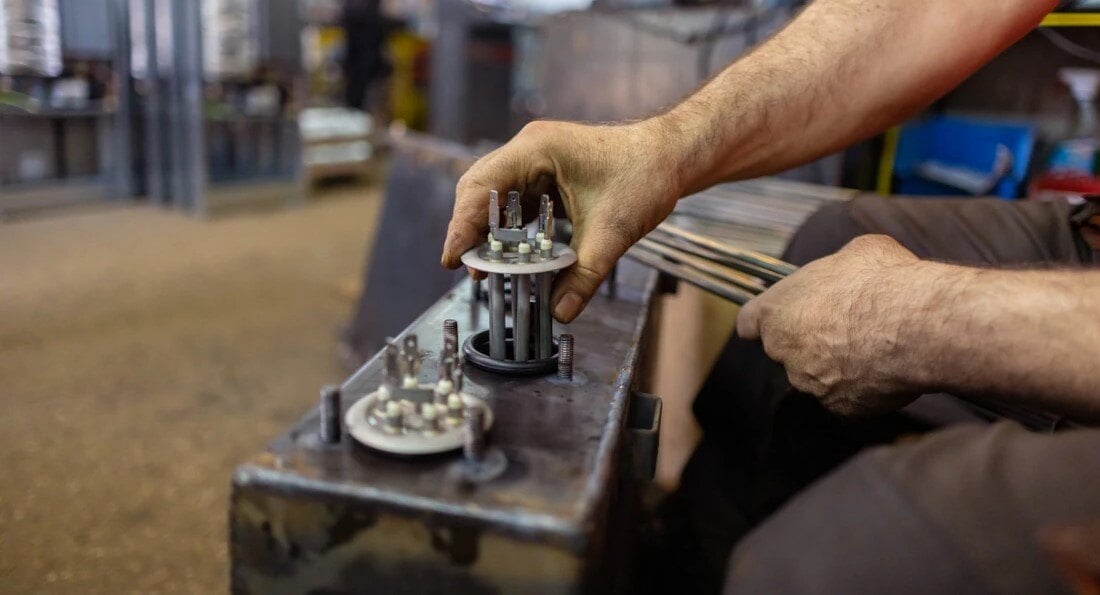Vacuum Furnace Heat Treatment for Stamping Tools & Dies

Tool failure during high-volume production runs can cost thousands in downtime, rejected parts, and emergency repairs. Even worse, inconsistent heat treatment often goes unnoticed until dimensional problems or premature wear force an unplanned shutdown.
Vacuum furnace heat treatment offers a proven way to eliminate oxidation, reduce distortion, and deliver consistent metallurgical properties that extend tool life. In this guide, we’ll explore how this advanced process works, why it’s gaining traction among precision manufacturers, and what factors to consider before moving forward.
Why Standard Heat Treatment Falls Short
Traditional atmosphere furnaces create several problems that compromise tool performance:
- Surface oxidation requiring costly post-treatment cleaning
- Dimensional distortion from uneven heating and cooling
- Inconsistent results due to atmospheric variations
- Environmental concerns from chemical cleaning processes
These issues compound over time, leading to frequent tool replacements, increased maintenance costs, and quality inconsistencies that affect your bottom line.
What Is Vacuum Furnace Heat Treatment?
Vacuum furnace heat treatment puts components in a controlled, oxygen-free environment. By removing air and creating a vacuum, the process eliminates oxidation, decarburization, and contamination – the leading cause of surface degradation and dimensional instability.
The process typically includes:
- Preheating: Ensures uniform temperature distribution throughout the tool
- Austenitizing: Transforms the material’s microstructure to harden it
- Quenching: Controlled cooling under inert gas to lock in properties
- Tempering: Balances hardness and toughness for specific applications
You can increase wear resistance by adding an optional cryogenic treatment, which turns the retained austenite into martensite.
5 Key Benefits for Stamping Tools & Dies
Stamping tools and dies are essential to achieving high-quality, precise, and durable metal components. To ensure these tools perform at their best and last longer, manufacturers often rely on advanced heat treatment methods.
Vacuum furnace heat treatment has become a preferred choice for toolmakers and manufacturers because it delivers exceptional performance, consistency, and efficiency compared to conventional processes.
Key benefits of vacuum furnace heat treatment are:
- Oxidation-Free Processing
- Superior Dimensional Stability
- Consistent Metallurgical Properties
- Extended Tool Life
1. Oxidation-Free Processing
The vacuum environment eliminates surface oxidation completely. This means no post-treatment pickling, blasting, or grinding – reducing both processing time and costs while maintaining pristine surface finish.
2. Superior Dimensional Stability
Another benefit is the ability to maintain dimensional stability. As a stress-relieving process, heat treatment proactively prevents material movement during manufacturing, ensuring that tools maintain the precise shapes necessary for parts used in industries demanding absolute accuracy. Tools maintain tighter tolerances, reducing the need for extensive finishing operations and improving part consistency.
3. Consistent Metallurgical Properties
Precise temperature and atmosphere control ensure repeatable results batch after batch. This consistency extends predictable tool life.
4. Longer Tool Life
Vacuum furnace heat treatment typically extends tool life by 25-40% compared to conventional methods. This translates to fewer tool changes, reduced maintenance downtime, and lower cost per part. A durable tool is essential for resisting the inevitable wear and tear stamping dies experience during repeated high-pressure operations.
By improving properties such as hardness and wear resistance, vacuum furnace heat treatment ensures that high-performance materials like hardened tool steel and carbide can significantly extend the operational life of metal stamping dies. This increases productivity and preserves part quality over longer production runs.
Vacuum Furnace vs. Conventional Heat Treatment
|
Factor |
Vacuum Furnace |
Conventional Heat |
|
Surface Quality |
Oxidation-free, No Scale |
Surface Oxidation, Scale Formation |
|
Dimensional Stability |
Minimal Distortion |
Higher Distortion Risk |
|
Post-Treatment |
Often Unnecessary |
Cleaning & Pickling Required |
|
Consistency |
Highly Repeatable |
Variable Results |
Vacuum furnaced heat offers a combination of precision, performance, and sustainability that’s difficult to match with conventional methods. It helps manufacturers reduce costs, improve quality, and operate more efficiently — making it a smart investment for any stamping operation.
In-House vs. Outsourced Heat Treatment: Making the Right Choice
Choosing between in-house and outsourced heat treatment for your stamping tools and dies is a critical decision that impacts efficiency, cost, and production flow. Consider the following factors to determine the best approach for your operations:
Benefits of In-House Heat Treatment
Bringing heat treatment in-house significantly reduces lead times, with parts ready for grinding in just 3-4 days, compared to a 2-week minimum when outsourcing. This dramatically enhances deliveries and overall workflow.
Keeping the work under your roof provides greater control over production timelines and quality, enabling faster adjustments and a more responsive production environment.
When to Consider Outsourcing
That said, it’s not always smarter to stay in-house. There are several reasons to outsource heat treatment – consider the following:
- Specialized Treatments: Access specific heating processes not available internally.
- Lower Production Volumes: Ideal for businesses with smaller or infrequent heat treatment requirements.
- Limited Capital Investment: A suitable option if your budget doesn’t have room for more processing equipment.
To determine the most cost-effective solution, calculate your current heat treatment expenses, including lead times, transportation costs, and any rework. Compare these figures against the potential return on investment of new equipment and the operational savings achievable through an in-house setup.
Critical Applications for Stamping Dies
Vacuum heated treatments enhance the performance of stamping dies in various critical applications, delivering substantial benefits to operational efficiency and product quality. The process offers the greatest impact for:
- High-volume progressive dies: Extending their lifespan, thereby reducing the frequency of costly changeovers.
- Precision forming tools: Maintaining their dimensional accuracy over extended production runs.
- Complex cutting dies: Preserving sharp edges and minimizing burr formation, leading to cleaner cuts and less post-processing.
These advanced heat treatments are vital for components in industries like aerospace (e.g., brackets, engine parts), automotive (e.g., fuel injector components, electrical motor components), and medical devices (e.g., surgical instruments, implantable components).
The ability of vacuum furnace heat treatment to ensure oxidation-free, decarburization-free, and carburization-free results makes it ideal for high-performance applications where precision and surface quality are paramount.
Factors to Evaluate
Before choosing vacuum furnace heat treatments, consider several key factors to ensure optimal results and a successful integration into your manufacturing process:
Material Compatibility
- Different tool steels react uniquely to vacuum processes.
- Always verify the appropriate temperature profiles for your specific steel grade.
- Assess how alloy composition may influence the quenching process.
Part Geometry
- Complex shapes might necessitate custom fixtures.
- Thick sections will require adjusted heating cycles.
- Assemblies with multiple components demand meticulous planning.
Production Volume
- Higher production volumes can justify the investment in in-house equipment.
- Calculate the break-even point to determine the most suitable approach for your operation.
Integration
- Ensure compatibility with subsequent coating and surface treatments.
- Verify dimensional requirements for all finishing operations.
- Plan for any necessary modifications to inspection procedures.
Careful evaluation of these factors will help you maximize the advantages of vacuum furnace heat treatments for your stamping die applications.
Warning Signs Your Current Heat Treatment Isn’t Working
If you're noticing problems with your stamping tools and dies, your current heat treatment method might be the culprit. Watch for these indicators that vacuum furnace heat treatment could offer a solution:
- Frequent tool replacement
- Inconsistent part dimensions
- Excessive post-treatment finishing
- Surface quality issues
- High rework rates
These indicators are often subtle signs of underlying issues that can be proactively addressed through a comprehensive quality assurance framework. To determine if vacuum furnace heat treatments are a good fit for your operations, consider these steps:
- Audit current tool life data: Document actual tool performance against expected outcomes.
- Calculate total heat treatment costs: Be sure to include hidden expenses like extra finishing or reworks.
- Identify pilot applications: Start by testing the process on high-impact, measurable tools.
- Consult with specialists: Review material specifications and process requirements with experts.
By recognizing these warning signs and taking these evaluative steps, you can assess whether a shift to vacuum furnace heat treatment will benefit your operations.
Ready to Improve Your Tool Performance?
For stamping tools and dies, vacuum furnace heat treatments offer clear advantages over traditional methods, leading to consistent precision and a longer lifespan. The combined benefits result in measurable improvements in tool performance and manufacturing efficiency.
By carefully assessing your material requirements, production volumes, and integration needs, you can determine if this advanced heat treatment process will provide your operation with worthwhile quality improvements and cost savings.
You May Also Like
These Related Stories

Tool and Die Repair Maintenance

Using the Electrochemical Machining Process for the Aerospace Industry

%201.png?width=146&height=103&name=Slice%203%20(72)%201.png)

